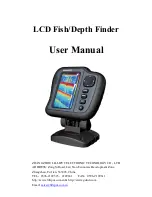
18
If you do change the transducer position, re-trace the position of the mounting
bracket before proceeding.
NOTE:
It is often necessary to make several incremental transducer adjustments before
optimum high speed performance is achieved. Due to the wide variety of boat hulls,
however, it is not always possible to obtain high speed depth readings.
6. Once you have reached a consistently good sonar signal at the desired speeds,
you are ready to lock down the transducer settings. Force the pivot to the Up
position to gain access to the mounting screws, then re-align the mounting
bracket against the transom of the boat to match the traced silhouette. Check the
bracket position with the level again to make sure it is still level, then mark the
third mounting hole using a pencil or marker. Unscrew and remove the mounting
screws and the transducer assembly and set aside.
7. Drill the third mounting hole, using a 5/32” drill bit. Use a marine-grade silicone
sealant to fill all three drilled mounting holes, especially if the holes penetrated
the transom wall.
NOTE:
On fiberglass hulls, it is best to use progressively
larger drill bits to reduce the chance of chipping or flaking
the outer coating.
8. Re-position the transducer assembly against the
transom of the boat, then hand-install all three
screws. Make sure that the transducer location and
the pivot angle have not changed, then fully tighten
all three mounting screws (see the illustration
Fully
Tighten All Three Mounting Screws
). Snap the pivot
back down. If you have performed the preceding
procedures correctly, the transducer should be level
and at the right height for optimal operation.
Fully Tighten All Three
Mounting Screws































